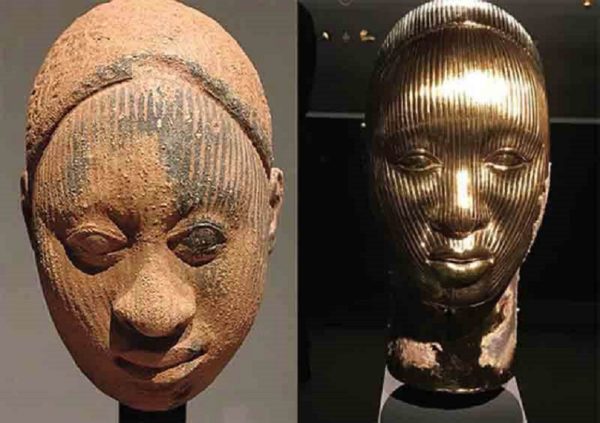
Recently, the Nigerian artist Victor Ehikhamenor called out the legendary British maestro, Damien Hirst, for appropriating Nigerian art in one of his latest exhibitions at the Venice Biennale. The said work, titled Golden Heads (Female), bears a startling resemblance to Ori Olokun, an ancient sculpture originating from as far back as the 13th century in the ancient Nigerian kingdom of Ile-Ife.
Ehikhamenor made an impassioned rant about the injustice in Hirst’s appropriation. He wrote on Instagram.
The British are back for more from 1897 to 2017. The Oni of Ife must hear this. “Golden heads (Female)” by Damien Hirst currently part of his Venice show “Treasures from the Wreck of the Unbelievable” at Palazzo Grassi. For the thousands of viewers seeing this for the first time, they won’t think Ife, they won’t think Nigeria. Their young ones will grow up to know this work as Damien Hirst’s. As time passes it will pass for a Damien Hirst regardless of his small print caption. The narrative will shift and the young Ife or Nigerian contemporary artist will someday be told by a long nose critic “Your work reminds me of Damien Hirst’s Golden Head.” We need more biographers for our forgotten. #ifesculptures#classicnigerianart #workbynigerianartist #ifenigeria#lestweforget#nigeria #abiographyoftheforgotten
Below is the artwork by Damien Hirst:
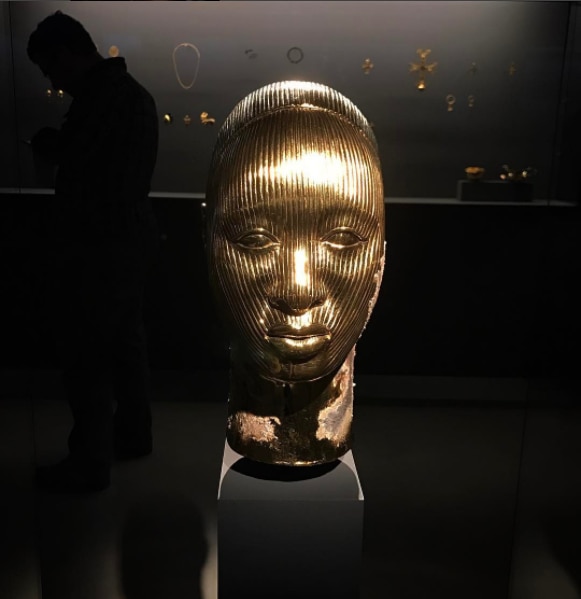
And here is Ori Olokun:
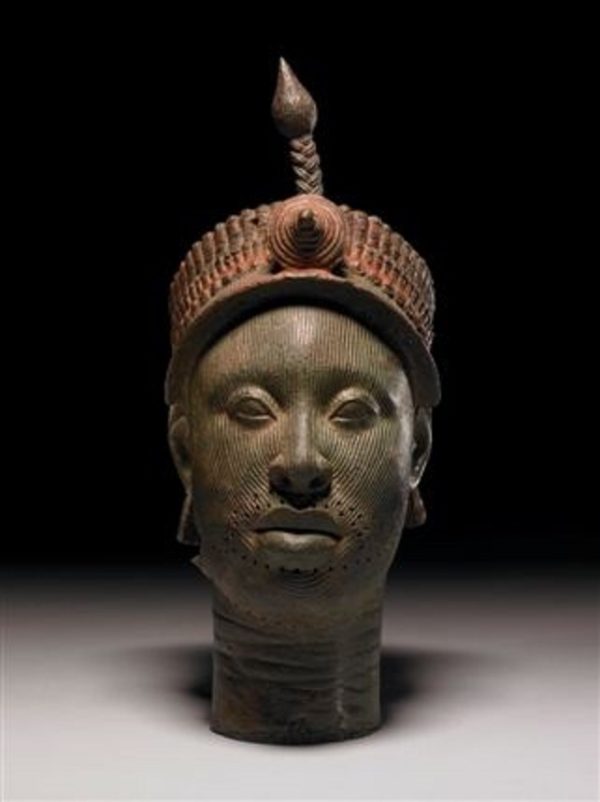
Hirst’s camp got on the defensive:
The treasures are a collection of works influenced by a wide range of cultures and stories from across the globe and throughout history—indeed many of the works celebrate original and important artworks from the past.
Here are five reasons Ehikhamenor’s response to the appropriation is totally warranted.
1. Hirst’s Appropriation is Part of a Larger Narrative
This scenario played out above is not new. It is merely another egregious case of imperialism—white artists with the access to an audience taking ownership of the intellectual properties of Africans. Too often, the soul of the African is battered by the theft of its offsprings. Hirst’s appropriation contributes to this disturbing narrative of discrediting the creativity of Africans, claiming the supposedly primitive art of Africans as one’s own.
Ironically, this sickening trend has been a powerful inspiration behind a lot of African art in recent times.. It is a theme emphasised in Chimamanda Ngozi Adichie’s Half of A Yellow Sun. Chinua Achebe’s life’s work is dedicated to addressing it. Gabriel Okara dwelt on that repeatedly in his poems. It inspired the viral spoken word video by Brunel University African Poetry Prize winner, Safia Elhilo, and Aziza Barnes, titled “To the Girl in My Jazz Class.” In the video, Elhilo and Barnes address an omnipresent white girl who claimed that recognising Bebop Jazz as black music is degrading to the art. To the girl, they said:
…this was not accident. This was not something we stumbled upon while making our primitive tribal art. You do not invite beauty into your home without asking at its birthplace. You will not make an orphan of our [art].
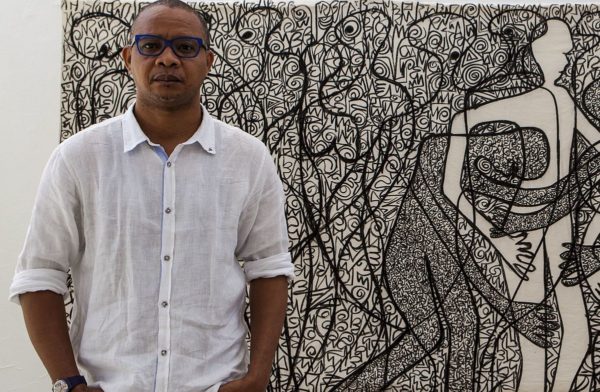
2. History Will Value Hirst’s Artwork More Than the Original
Another depressing reality is the fact that Damien Hirst’s Golden Heads will most likely end up getting far more “mainstream” acclaim and recognition as an original contribution to art than the work of the Ife people. The prospect of this is maddening. And anger is the perfect response to such utter disrespect.
It is not just about art but the subject of discovery itself. Throughout history, we have been taught in our classrooms that the white people “discovered” places known to Africans prior. The story of Mungo Park comes to mind now—a Scottish explorer famed for discovering the Niger River, which black people had been bathing in and drinking from centuries before Park’s birth.
It Otherises the experiences of the African people as insignificant until validated by the West, through this tendency to carefully re-present distinctly African art as a more “modern” and “edgy” Euro-American invention.
3. African Artists Are Denied Their Rightful Agency
It is no news that African art creators of all kinds are hardly given their due. The few who do achieve recognition are expected to dedicate their success to the benevolence of foreign establishments. They are expected to perform gratitude, to credit the stylistic-cum-thematic growth of their work to the influence of these Western circles. This is one of the considerations that made Binyavanga Wainanaina call for the de-legitimisation of the Caine Prize. While his comments were certainly divisive, his argument that it creates an unhealthy dependency is not avoidable.
We do have agency. But we are consistently denied that important recognition and we need to take that back. When a foreign artist tries to take what is ours, we need to actively defend the dignity of our people and the collective history of our ancestors, all of which have led us here. Ehikhamenor does exactly that, standing up for the right of Africans to be praised for their agency.
4. Hirst Fictionalises and Undermines a Crucial Symbol of African History
Art is a people’s expression of their subjective standards of beauty. It is their way of communicating their spirit as a race. Therefore, to take that for oneself, to turn it into nothing more than a glorified piece of shiny bronze-ware which will transmogrify into dollars in a foreign pocket is not acceptable.
The artwork is part of the heavily-praised Treasures From the Wreck of the Unbelievable, an exhibition with a fictional backstory. In Hirst’s fictionalisation, Golden Heads is just one of the many ancient treasures found in 2008 off the coast of East Africa from the wreck of a ship which sank about 2,000 years ago.
Some may argue that Yoruba is not the only culture Hirst “borrows” from but that is beside the point. People like Hirst need to understand that we have a history of being defensive about such supposed borrowings. Our art was not made by our ancestors just for aesthetic purposes or as a work of potentiality to be made whole centuries later by a foreigner, but as a fulfillment of our spiritio-religious longing for the power of something beyond our physical existence. This particular work was inspired by an orisha and it speaks to our existential struggle to come to terms with our ideas of anthropomorphic-yet-supernatural gods. Hirst undermines that struggle by presenting it as something to own, to add his tiny sprinklings of creativity to and show off as a masterpiece borne from his oh-so genius mind. We are not having it!
5. It Normalises Exploitation
All of these still lead to the idea of exploitation. Hirst is valued at £215m and this new exhibition is about to make him a whole lot richer. Ehikhamenor merely joins the company of Marco Pierre White, Norman Emms, Robert Dixon, John LeKay, Charles Thompson and others who have accused Hirst of stealing from others to enrich his pockets.
To keep quiet about this is to normalise the exploitation of not just other artists but of the art of ancient cultures which have such depth of meaning, the kind that is incomprehensible to those who are not initiated into such cultures. The sweat and toil of those people should not become nothing but a source of enrichment. Exploitation should not be met with neutrality. Too often, black art is made profitable to white pockets. Let’s confront that.
We are a people who have been battered by colonialism. It broke our world into irreconcilable halves and we are severed from our past. The only few instances of connection to our ancestors are these relics of time and we deserve a monopoly of authority over such relics. You do not have our permission to be “influenced” by it. We are a broken people looking to fix ourselves with the opium left behind and you taking that for granted is one of the gravest offences you can commit. People like Hirst must be able to unpack their defensiveness about that. We are not here for such tone-deafness and Ehikhamenor made that clear.



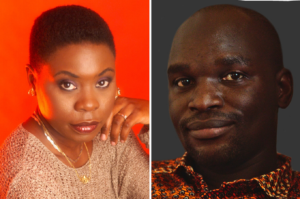
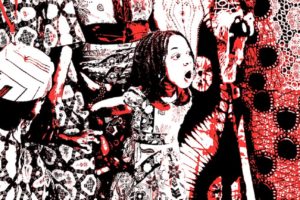
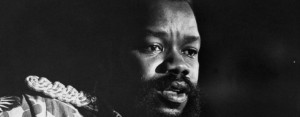
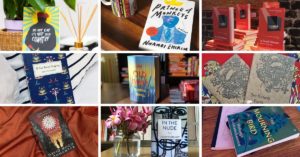

David Price August 26, 2017 06:26
I agree 100% it's not really the influence that bothers me so much as it is the blatant attempt to steal and copy something our ancestors put their blood,sweat and tears into creating it's the fact that when I look at his bullshit attempt at appropriating our art all I see is a soulless shell of what our ancestors created and that's what kills me the most.